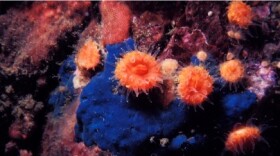Federal biologists have indefinitely suspended a satellite tagging program to track endangered orca whales. The move comes after an expert panel concluded a fungal infection contributed to the death of a 20-year-old member of the L pod.
The panel, convened by scientists at the National Oceanic and Atmospheric Administration’s Northwest Fisheries division, said in its report that pieces of the tag remained in the wound site after it detached and may have been the source of the infection. The small satellite-linked device is designed to detach and leave nothing behind.
L95 – also known as Nigel – was found dead last spring off the coast of Vancouver Island roughly five weeks after the animal was tagged by NOAA scientists. A necropsy and follow-up report indicate that the fungal infection likely entered the animal's bloodstream at the wound site and that the infection contributed to the whale's death. Veterinary medical officer Deborah Fauquier said in a conference call with news media that after a failed first tagging attempt, the dart had fallen into the water and then was not sufficiently disinfected.
“So it could have come in from the improper sterilization for the second attempt from the sea water. Additionally, there were retained petals of the tag in the wound,” she said. “So the fungus could have been seeded with those retained petals.”
The report also says the dart hit close to large blood vessels near the dorsal fin, which likely contributed to the spread of the infection.
NOAA has convened an independent science panel to consider all the factors and see if there is a safe way to resume tagging. The agency says in order to protect endangered southern resident Orcas, more information is needed about where they go and what they do in winter.
Some advocates think the program should be permanently discontinued. NOAA says that is one potential outcome. But there may be less invasive ways to get information, such as through underwater monitoring of hydrophones or by replacing dart tags with suction cups that don’t stay attached for as long but would still provide some tracking information.
Chief Scientist Richard Merrick says they’ve suspended the tagging program until they can find ways to make it safer. Two panels inside the agency are looking for improvements. In addition, a tagging workshop planned by the International Whaling Commission is set for spring 2017. Discussions will include re-evaluation of tag design and other sources of tag failure. There will also be consideration of whale physiology and optimal location of tags to minimize risks to the animals’ health.
“NOAA and the biologists who work on these whales are dismayed that one of their tags may have had something to do with the death of this whale,” Merrick said.
“While we have stopped with the satellite tagging of southern residents, we continue to work hard for their recovery. Our other research on the threats that face these whales will continue and we’ll press ahead aggressively on our recovery priorities.”
The scientists say extenuating factors may have predisposed L95 to a fungal infection, including "human error" from not sterilizing the dart tag after it had fallen into the water. The animal's health may have been compromised at the time it was tagged in February.
The L pod is one of three groups of southern resident Orca whales that spend much of the year in Puget Sound and the Salish Sea. Their numbers depend largely on the availability of Chinook salmon, which is also an endangered species and is their preferred food source. That’s in contrast to the less selective transient orcas, whose diets consist of a range of marine mammals including seals, sea lions, walruses, baleen whales, other toothed whales, and occasionally sea otters.
NOAA says the current population of the endangered resident killer whales is 82, seven of which are still tagged for tracking.







